

Uncertainty In Natural Climate Forcing Is 870 Times Larger Than CO2 Forcing – A CO2 Signal Is Thus Not Detectable. Clouds regulate Earth’s climate.

New studies suggest uncertainty in clouds’ surface radiative effects reach 17.4 W/m² per year (±8.7 W/m²/year). Total CO2 climate forcing is said to be just 0.02 W/m² per year. The difference in these magnitudes preclude detection of a CO2 signal in climate forcing. According to Feldman et al. (2015), a 2 ppm increase in CO2 per year (22 ppm over the 11 years from 2000-2010) results in a surface radiative forcing influence of 0.02 W/m², or 0.2 W/m² per decade. This is said to be just “ten per cent of the trend in downwelling longwave radiation” when clouds and water vapor are considered.
In contrast, the influence of clouds in total longwave forcing is substantially larger, with radiative forcing trends reaching ±4 W/m² per decade. From 1978 to 2010, the total longwave anomalies reached amplitudes of about ±2 W/m² per year (Loeb et al., 2012, below image). Image Source: Loeb et al., 2012 Image Source: L’Ecuyer et al., 2019. How Much Sun Could A Sunshine Shine? Guest Post by Willis Eschenbach It has been pointed out that while many of the global climate models (GCMs) are not all that good at forecasting future climate, they all do quite well at hindcasting the 20th-century global temperature anomaly [edited for clarity – w.].
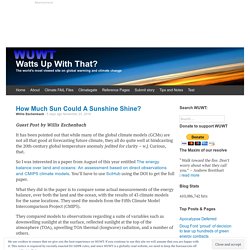
Curious, that. Scientists Cite Uncertainty, Error, Model Deficiencies To Affirm A Non-Detectable Human Climate Influence. By Kenneth Richard on 21.

November 2019 Observational uncertainty, errors, biases, and estimation discrepancies in longwave radiation may be 100 times larger than the entire accumulated influence of CO2 increases over 10 years. This effectively rules out clear detection of a potential human influence on climate. The anthropogenic global warming (AGW) hypothesis rides on the fundamental assumption that perturbations in the Earth’s energy budget – driven by changes in downward longwave radiation from CO2 — are what cause climate change. According to one of the most frequently referenced papers advancing the position that CO2 concentration changes (and downward longwave radiation perturbations) drive surface temperature changes, Feldman et al. (2015) concluded there was a modest 0.2 W/m² forcing associated with CO2 rising by 22 ppm per decade.
Again, that’s a total CO2 influence of 0.2 W/m² over ten years. 1. Image Source: Kim and Lee, 2019 2. Image Source: Kato et al., 2018 3. 4. Climate’s uncertainty principle. By Garth Paltridge On the costs and benefits of climate action.

Whether we should do anything now to limit our impact on future climate boils down to an assessment of a relevant cost-benefit ratio. That is, we need to put a dollar number to the cost of doing something now, a dollar number to the benefit thus obtained by the future generations, and a number to a thing called “discount for the future”—this last being the rate at which our concern for the welfare of future generations falls away as we look further and further ahead. New study attempts to “squeeze out” uncertainty in climate models. From the “we’re gonna need a bigger computer” department.
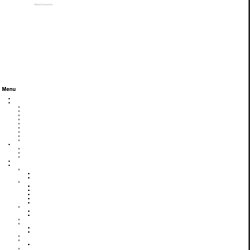
Climate model uncertainties ripe to be squeezed The latest climate models and observations offer unprecedented opportunities to reduce the remaining uncertainties in future climate change, according to a new study. Although the human impact of recent climate change is now clear, future climate change depends on how much additional greenhouse gas is emitted by humanity and also how sensitive the Earth System is to those emissions. Reducing uncertainty in the sensitivity of the climate to carbon dioxide emissions is necessary to work-out how much needs to be done to reduce the risk of dangerous climate change, and to meet international climate targets.
The study, which emerged from an intense workshop at the Aspen Global Change Institute in August 2017, explains how new evaluation tools will enable a more complete comparison of models to ground-based and satellite measurements. Lead author Veronika Eyring, of DLR in Germany,said: Panicking about climate change? See the rest of the story.
Summary: Contrast alarmists’ “news” about the climate with the estimates produced by real scientists.
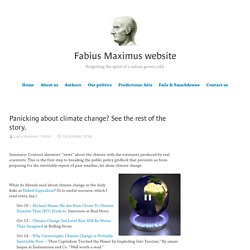
This is the first step to breaking the public policy gridlock that prevents us from preparing for the inevitable repeat of past weather, let alone climate change. What do liberals read about climate change in the daily links at Naked Capitalism? (It is useful resource, which I read every day.) Climate uncertainty monster: What’s the worst case? By Judith Curry On possibilities, known neglecteds, and the vicious positive feedback loop between scientific assessment and policy making that has created a climate Frankenstein.

I have prepared a new talk that I presented yesterday at Rand Corp. My contact at Rand is Rob Lempert, of deepuncertainty.org fame. Very nice visit and interesting discussion. My complete presentation can be downloaded [Rand uncertainty]. Scientists are saying the 1.5 degree climate report pulled punches, downplaying real risks facing humanity in next few decades, including feedback loops that could cause ‘chaos’ beyond human control. Summer 2018 Variations: Uncertainty in climate projections. The lure of incredible certitude. By Judith Curry “If you want people to believe what you *do* know, you need to be up front about what you *don’t* know.”- Charles Manski Twitter is great for networking.
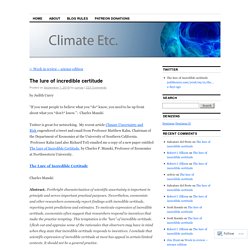
My recent article Climate Uncertainty and Risk engendered a tweet and email from Professor Matthew Kahn, Chairman of the Department of Economics at the University of Southern California. Professor Kahn (and also Richard Tol) emailed me a copy of a new paper entitled The Lure of Incredible Certitude, by Charles F. Manski, Professor of Economics at Northwestern University. Model Uncertainties Too Great To Reliably Advise Policymakers, German Scientists Say. German scientists Dr.

Sebastian Lüning and Prof. Climate Models Are Uncertain, but We Can Do Something About It. Model uncertainty is one of the biggest challenges we face in Earth system science, yet comparatively little effort is devoted to fixing it.
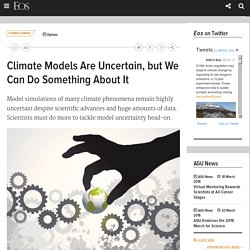
A well-known example of persistent model uncertainty is aerosol radiative forcing of climate, for which the uncertainty range has remained essentially unchanged through all Intergovernmental Panel on Climate Change assessment reports since 1995. From the carbon cycle to ice sheets, each community will no doubt have its own examples. We argue that the huge and successful effort to develop physical understanding of the Earth system needs to be complemented by greater effort to understand and reduce model uncertainty. Without such reductions in uncertainty, the science we do will not, by itself, be sufficient to provide robust information for governments, policy makers, and the public at large. Model Wiggle Room As British statistician George Box famously said, “all models are wrong, but some are useful.” A veneer of certainty stoking climate alarm. In-depth: Scientists discuss how to improve climate models. While global climate models do a good job of simulating the Earth’s climate, they are not perfect.
Despite the huge strides taken since the earliest climate models, there are some climatic processes that they do not simulate as accurately as scientists would like. Advances in knowledge and computing power mean models are constantly revised and improved. As models become ever more sophisticated, scientists can generate a more accurate representation of the climate around us. But this is a never-ending quest for greater precision.
Uncertainties, Errors In Radiative Forcing Estimates 10 – 100 Times Larger Than Entire Radiative Effect Of Increasing CO2. Scott Pruitt, the new head of the U.S. Environmental Protection Agency, has recently been characterized as a climate science “denialist” by world news organizations. A UK Guardian headline, for example, has claimed that “EPA head Scott Pruitt denies that carbon dioxide causes global warming“. Dr. Judith Curry speaks out on climate science’s fatal flaw – the failure to explore and understand uncertainty. Guest essay by Larry Hamlin Dr.
Judith Curry conducted an interview on British radio on February 6th addressing, among many topics, how the politicalization of climate science created and driven by the UN IPCC process has robbed scientists of the opportunity to explore the legitimate, extremely important and yet unaddressed issues of how natural climate change drivers impact the earth’s climate. Her excellent broadcast can be found here: During the course of her interview Dr. No Certain Doom: On the Accuracy of Projected Global Average Surface Air Temperatures. Alternative approach to assessing climate risks.
By Judith Curry At one level, analyzing climate risks is a matter of due diligence, given mounting scientific evidence. However, there is no consensus about the means for doing so nor about whether climate models are even fit for the purpose. An alternative to the scenario- led strategy, such as an approach based on a vulnerability analysis (“stress test”), may identify practical options for resource managers. – Brown and Wilby At the recent Royal Society Workshop on Handling Uncertainty in Weather and Climate Prediction, among the interesting people that I met was Robert Wilby, who has an article in the latest issue of EOS.
Citation: Brown, C. and R. Taming the Uncertainty Monster. Two (+1) new uncertainty papers. Verification, validation, and uncertainty quantification in scientific computing. By Judith Curry I think I am gaining some insight into the debate between scientists versus engineers regarding climate model verification and validation. Uncertainty in health impacts of climate change. Throwing down the gauntlet on reproducibility in Climate Science – Forest et al. (2006) After spending a year trying to get the data from the author without success, Nic Lewis has sent a letter to the editor of Geophysical Research Letters (GRL) and has written to me to ask that I bring attention to his letter published at Judith Curry’s website, and I am happy to do so. Uncertainty in observations of the Earth’s energy balance.
Meta-uncertainty in the determination of climate sensitivity. Uncertainty in SST measurements and data sets. Ocean heat content uncertainties. Are the deep oceans cooling? Ethics of communicating scientific uncertainty. Stalking the uncertainty monster. Managing uncertainty in predictions of climate change and impacts. Alternative approach to assessing climate risks. Coping with deep climate uncertainty. Deep Uncertainty of Climate Sensitivity Estimates: Sources and Implications. Judith Curry - Climate Science and the Uncertainty Monster.